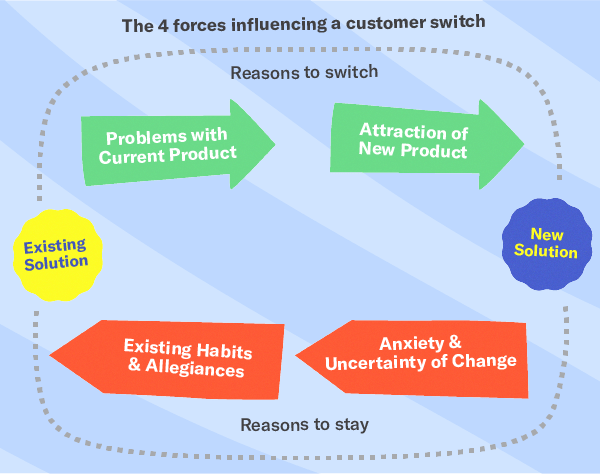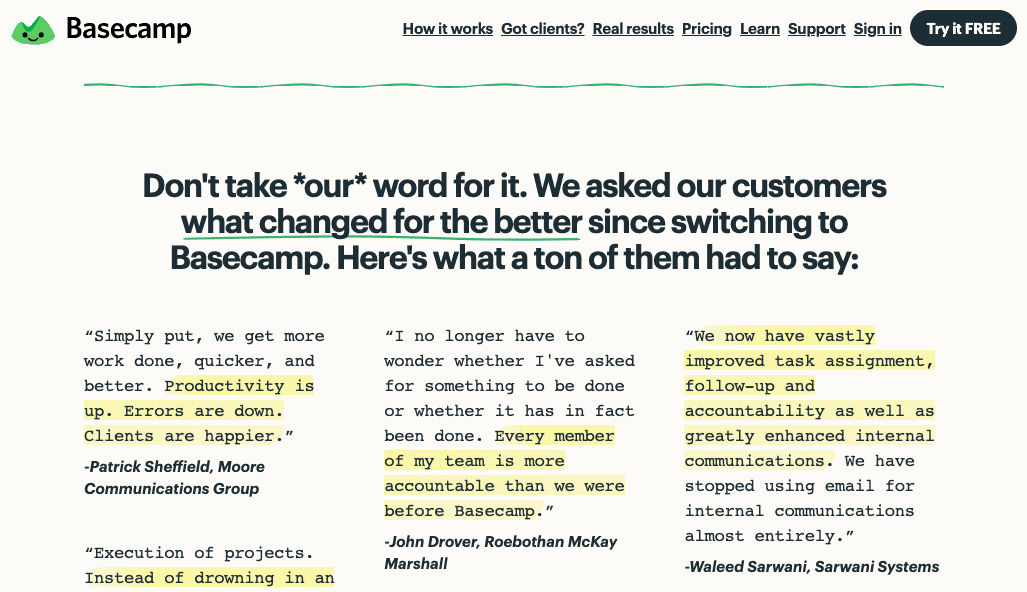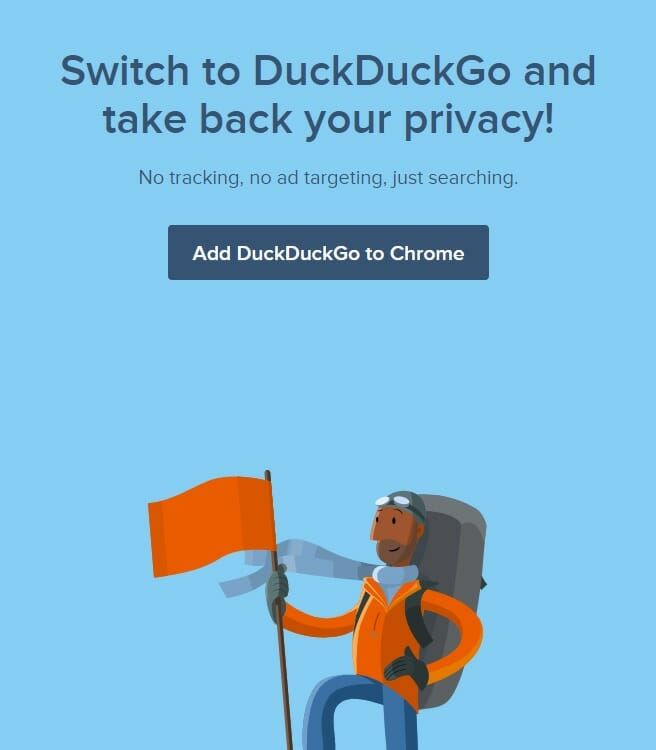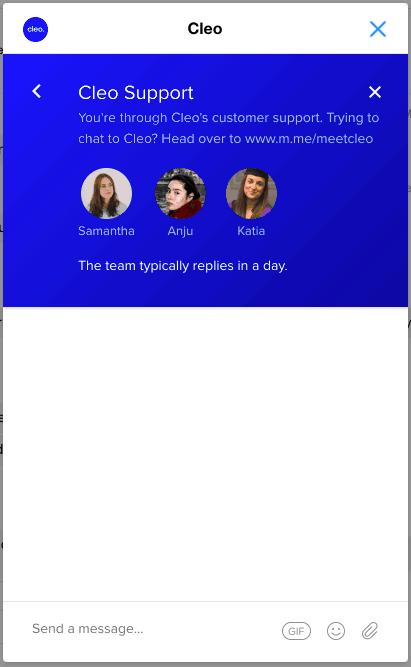
Product adoption: how to get customers to embrace your product
Main illustration: Colby Brooks
All products share a universal problem. No matter how long they’ve been around or how well they are built – the problem of customer inertia.
Your potential customers are probably more comfortable staying where they are rather than taking a chance on something new. Luckily, there are ways to convince them to make a switch and increase your product adoption.
Whether you’re getting ready for your first product launch or announcing your fiftieth feature, here are a few tips we’ve learned to help you overcome customer inertia and help users see the value of what you have to offer.
What is product adoption?
Product adoption describes the process of users becoming aware of a product, understanding its value, and beginning to use it. The process is usually broken down into four discrete stages: awareness, interest, evaluation and conversion.
When people think about product adoption, often metrics like the number of sign-ups or daily active users come to mind. But these metrics taken in isolation don’t reflect whether users are successfully incorporating your product into their daily routine, adding it to their lineup of business tools or embracing it as something they can’t do without. True product adoption comes when the value of your product is so great that it outweighs the effort and cost required of the user to make a change.
Keep in mind it’s not just new users or early adopters you need to win over. As you add new features and make improvements, you need to consider how to help existing customers continue to see value with your product.
4 forces that influence product adoption
Here at Intercom, we worked with The Re-Wired Group early on to apply the Jobs to be Done framework to our product strategy. The group identifies four forces at play when it comes to product adoption. Two of the forces typically work in your favor, while the other two work against you.

The Re-Wired Group calls this the Progress Making Forces diagram
With the right marketing and product tactics, you can make all four of those forces work in your favor. You can do that – and increase product adoption as a result – by doing the following:
- Increase the push-away – Point out flaws in the prospect’s current product.
- Increase your product magnetism – Show how well your product solves the prospect’s problems.
- Decrease the fear and uncertainty of change – Explain how easy it is to switch to your product.
- Decrease their attachment to the status quo – Remove prospects’ fondness for their current product.
Let’s take a closer look at how companies have used these forces effectively to increase product adoption.
1. Increase the push-away
Even if it’s not your style to speak badly of others, pointing out the flaws in your prospective customer’s current solution – and highlighting how your product makes up for any shortcomings – can do a lot to encourage people to churn, or at least consider the possibility of making a change.
Guru, the knowledge management tool, does this on its homepage by contrasting the old way of managing knowledge across teams and tools versus the new and better way (using their product). Their marketing taps into key emotions of frustration and relief to drive urgency and a desire for change. This demonstrates value in the product experience for your users, and convinces them to make the switch.

Guru’s homepage demonstrates how to increase the push-away
2. Increase your product magnetism
Picking up a new product, learning about it, and teaching others how to use it is – let’s face it – a hassle. The goal of this second force is to make your solution so appealing that the prospective customer is willing to take on the work of switching to a new product in order to experience your product’s benefits. Customer testimonials, case studies and product demos are all great ways to help potential customers visualize the business outcomes that your product can drive for them.
Check out how SaaS company Basecamp emphasizes customer testimonials on their website:

Basecamp’s homepage uses loads of testimonials to increase its product magnetism
The list seriously goes on and on. The website leaves little doubt that the product excels at what it does and drives real results.
3. Decrease the fear and uncertainty of change
A prospect may be well aware that their current solution has flaws – but do they really want to take the risk of switching? They may think, “What if it doesn’t work out?” Or “What if we all switch and everyone hates it?”
These are valid concerns, and it’s your job to alleviate them. But changing a prospect’s existing habits and allegiances often takes much more than a clever marketing strategy: First, you need to persuade them to download a trial, and then you need to show them value during the onboarding and training period.
How well you introduce a potential customer to your product ultimately determines whether or not they get the “aha” moment that our product researcher Lynsey Duncan describes here:
“Aha” moments can be tricky to define, but most of us know them when we see them. For instance, there is a common example of an “aha” moment that most people can identify with. Do you recall the first time you participated in a group message in WhatsApp and you suddenly realized this was nigh-on impossible to achieve in your phone’s native SMS app? While WhatsApp might have seemed to be a like-for-like replacement of SMS when you first heard of it, this moment of discovery reveals it to be something far more powerful and transformative.
Your onboarding needs to lead to this kind of “aha” moment – not simply act as a tour of your existing features. It is the key to a potential customer realizing the value they can really get out of your product and feeling less fear about switching away from their current solution.
4. Decrease their attachment to the status quo
You’ve probably heard at least one prospect say they chose their current solution because it was recommended by a friend, or because “it seemed like everyone else was using it.” It’s a lot easier to feel comfortable with a product if we know there’s a community around it or there’s someone you can turn to for immediate answers to your questions.
But what’s right for the majority isn’t right for everyone. Some companies even center their product marketing campaigns on this “we’re-not-for-everyone” thinking, while others hone in on what makes them different from the most-used products. Take DuckDuckGo, for example:

DuckDuckGo plays up its advantage over the status quo
DuckDuckGo’s marketing is a direct hit on larger search engines, like Google and Bing, that track and monetize a user’s search activity. The company knows their prospects well of people concerned about their online privacy. As a result, the messaging focuses first and foremost on those potential benefits.
What can you do to draw your prospects’ attention to your benefits over their feelings of belonging? It may be as simple as promising a feature they’re desperately missing (like online privacy) or mentioning the support options you have in place (so they don’t have to ask a friend for help).
3 techniques to improve product adoption
Working with these four forces of customer influence can go a long way in convincing prospects to switch to your product or try out an app you’ve just released. But they’re certainly not the only keys to driving successful product adoption.
Here are three things to try if you’re not seeing the results you anticipated:
1. Improve your onboarding experience
Successful user onboarding doesn’t just show a customer where to go and how to do things; it also shows them how they’ll gain value from your product. Everyone who uses your product has at least one goal in mind. It may be to save time, make money and connect with users. Onboarding is how you guide them to those goals as soon as possible.
Our all-new Product Tours lets you walkthrough your onboarding flow based on factors like a user’s in-app behavior, how many times they’ve visited, what features they’ve used and more, so that every user has an onboarding experience that speaks directly to his or her individual goals.
Product Tours let you easily create interactive guided flows
2. Improve your product
Sometimes it’s not the onboarding experience that causes a prospect to reject your product – it’s the product itself.
If you suspect your product is underdelivering, that doesn’t mean you should immediately add new features or change the UI. Instead, take our co-founder Des’s advice on using a more nuanced approach to find ways you can improve:
- Add new features to increase adoption by your existing customers Are users directly asking for a new feature? Since adding something new can be risky – and customers may ask for features they won’t necessarily use – ask them to prioritize: “Would you rather have a calendar integration or a tab for customer notes?”
- Make improvements designed to increase frequency of usage. If users aren’t using a feature often, smart changes can improve that feature’s appeal. For a search tool, that might mean adding more filters or increasing the speed at which search results are delivered.
- Make improvements specifically targeted at increasing net new adoption. If users say something like “I’ll use this as soon as I can . . .” or “I’m not using this yet because I can’t . . .” it indicates that a few changes can increase product adoption.
3. Make support more accessible
If customers can’t figure out how to use your product – even with guidance – they’ll leave. With limited time in their schedules and plenty of alternatives on the market, it’s usually easier to stick with their current solution or workflow – or check out your competitor’s app – than it is to browse your help docs or sign up for a training.
So the final way you can improve your product adoption process is to make your support more accessible. Ideally, the process of asking for and receiving help should never take a user out of your app: If they leave, there’s a chance they’ll never come back. You can increase the accessibility of your support options in the following ways:
- Embed videos – Short demo videos should be added in a pop-out, overlay or tab within your app so users can get the help they need and then get right back to work.
- Offer in-app chat – Chat gives your customers a way to quickly ask questions, get advice or understand what they need to do to solve problems. With Intercom’s conversational support solution, users can access chat right from your website or inside your app, so they don’t have to abandon their task to get help.
- Use chatbots for a large user base – If your support team isn’t available, use chatbots to directly answer questions and help customers with simple tasks. In fact, we’ve found that almost a third of all support questions can be answered by a chatbot.
Check out how Cleo uses our Resolution Bot to manage close to 200 inbound chats coming in daily.

Avoid product rejection by overcoming customer inertia
Although your prospects may be reluctant to try new products, you can target the root causes of their reluctance to overcome inertia. Explain how your product can help prospects meet their goals and they’ll stop focusing on the hassle of making the switch – and start seeing everything they have to gain.







